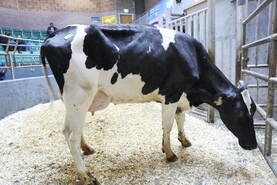Most of our cattle are now housed for winter, which allowed us to trial the changes we made for feeding youngstock inside.
Troughs have been set up in the enclosed lying area of the middle pen and calves can access them from each side through new creep entrances. While most of the calves are fitting through nicely, one of our more muscled bull calves managed to get completely jammed at the hips, and to make matters worse, he then sat down on his haunches leaving him stuck fast.
With the gates being new, cutting them with the angle grinder was going to be a last resort, and while he didn’t appear stressed, my immediate concern was getting him out as quickly as possible. A couple of years ago, we released a bull’s head which was trapped in a gate by using a bottle jack to give us a crucial extra inch of leverage. Unfortunately, this time it wasn’t possible as the bars were reinforced on each side, leaving us with the alternative option of trying to make the calf fit through.
For the second time in his life, the bull was doused in calving lubricant and with a bit of pushing and pulling, we managed to squeeze his rump out through the gate. Certainly a first for me, as I’ve never had to pull a calf twice before!
All trained to the creep pen! Two blues won't fit in so white fella walks in via the big gate & black boy eats from the end of the trough ??
— Karen McCabe (@LadyHaywire) October 21, 2020
Poor Peach is jealous! Very happy with how Rambo is doing for a heifers end of April calf. pic.twitter.com/nHkVWChNXp
Outfarm adventure
Bringing the stock inside meant we also had the annual adventure of taking home our cattle from the outfarm.
One cow in particular will neither lead nor drive and if she feels like she’s being forced into somewhere she doesn’t want to go, she lets fly with a volley of kicks that any mule would be proud of. Loading her would be difficult for any outsider who didn’t know her quirks, and each year when she goes on to the trailer, we have to offer the carrot approach instead of a stick. This means simply standing back and waiting for her to walk up the ramp at her own discretion, regardless of how long it takes.
We mixed cows outside so they wouldn't fight on the slats, they wanted to get back in this morning ??
— Karen McCabe (@LadyHaywire) November 7, 2020
Two are being left out to graze our lower fields, old Maxy & her daughter young Max, cause we know they won't fight! pic.twitter.com/dhoyxzhQI6
Online selling
With those few cows from the other farm home and the main herd also inside, we sold our heaviest weanlings and a dry cow to make more room, giving us our first experience with online selling. While I miss the banter and laughs of chatting to everyone in the yard, there’s something to be said for sitting next to a warm fire and drinking tea while watching your animals being sold.
Guggy egg & watching the mart online. A clash of old & new Ireland ??
— Karen McCabe (@LadyHaywire) November 2, 2020
(for my non Irish friends, Guggy egg is an egg or two basically scrambled in a cup cooked on the top of the solid fuel cooker with lots of butter & salt) pic.twitter.com/FLXboHCn6c
Our aim most years is for calves born in late-spring to be sold as they reach seven or eight months of age. While we haven’t quite reached the highs of the weanling prices achieved last year, we’ve averaged around €2.50/kg for the first few. Ever optimistic, I hope to finish up closer to €3/kg when the remainder are sold before the end of the year.
Right, first job done for the day, two boys dropped off.
— Karen McCabe (@LadyHaywire) October 24, 2020
Now to get a vet appointment for a lame cat ?? pic.twitter.com/GwtlPT7txf
Not everything has gone smoothly on the breeding side however, as a few cows came into heat when we thought they were a couple of months in-calf.
As we try to run a closed herd for the most part, we inseminated them again, which is going to leave us with a portion of our cows as autumn calvers next year. Whilst it’s not ideal, and many would say to cut our losses and cull these cows, it’s rather difficult to do so when the cows go back a number of generations in the herd. Sometimes it’s better the devil you know, than the one you buy on a whim, and perhaps having split calving will work out better than expected.
As farming can require a positive frame of mind and an endless supply of enthusiasm, I won’t call it a failure just yet, I’ll call it an unplanned change of system.






 This is a subscriber-only article
This is a subscriber-only article









SHARING OPTIONS: